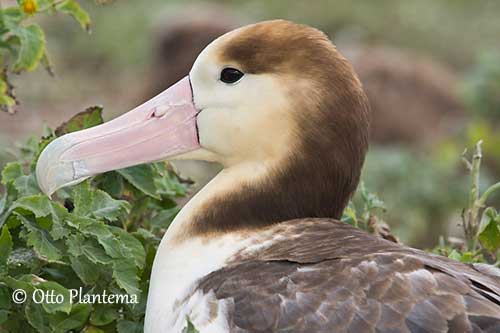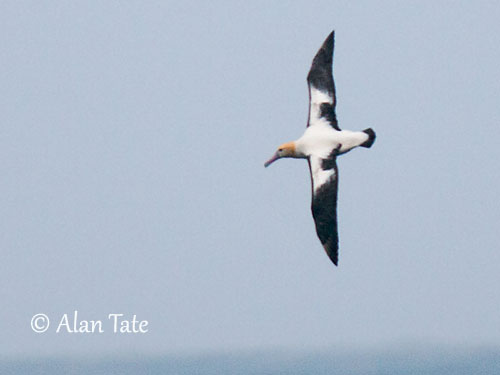
Fr: Albatros à queue courte
Ang: Short-tailed Albatross
All: Kurzschwanzalbatros
Esp: Albatros Colicorto
Ita: Albatros codacorta
Nd: Stellers Albatros
Sd: gulnackad albatross
Photographers:
Otto Plantema
Trips around the world
Alan & Ann Tate
AA Bird Photography
Text by Nicole Bouglouan
Sources:
HANDBOOK OF THE BIRDS OF THE WORLD vol 1 by Josep del Hoyo-Andrew Elliot-Jordi Sargatal - Lynx Edicions - ISBN: 8487334105
Bird Web (Seattle Audubon Society)
CREAGUS@Monterey Bay (Don Roberson)
Audubon - A brighter future for short-tailed albatross
Wikipedia, the free encyclopaedia
Alaska Department of Fish and Game
A C A P - Short-tailed Albatross
Short-tailed Albatross
Phoebastria albatrus
Procellariiformes Order – Diomedeidae Family
INTRODUCTION:
The Short-tailed Albatross is the largest seabird of the North Pacific, with a wingspan of more than two metres. It differs from other Diomedeidae by the large, pale bill at any age.
Only two breeding colonies are still active today on two Japanese islands, and the population is estimated to number about 2200/2500 birds, but it is now increasing, thanks to conservation measures.
This species is still threatened by loss of nesting habitats due to storms, volcanic eruptions and competition with other species such as the Black-footed Albatross that requires similar nesting habitat. Other usual threats such as predation by introduced mammals on islands, fishing nets, longline fishing, oil spills and ingestion of plastic debris make this species listed as Vulnerable.

DESCRIPTION OF THE BIRD:
Biometrics:
Length: 80-94 cm
Wingspan: 210-240 cm
Weight: 5100-7500 g
The Short-tailed Albatross adult is the only albatross with white back in North Pacific. It has white upperparts except the buffy-yellow wash on head and neck, more conspicuous on nape. The upperwing is black with white areas, one from scapulars and the other on inner secondary coverts, both connected by variable white area over the lesser coverts. The tail is black with white base.
The underwing is mainly white, surrounded by narrow black margin. The underparts are white.
The bill is pale pink with pale blue tip. The base of the bill is surrounded by narrow black line. The eyes are blackish-brown. Legs and feet are pale blue-grey or grey, with variable amount of pink on the webs, toes and tarsus.
Male and female are similar.
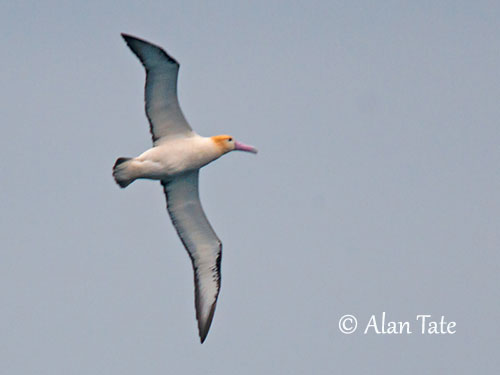
The juvenile is blackish-brown overall, with small white areas below the eyes and around the large, pale bill, and mainly on the chin.
The immature has more white on foreface and postocular line. The upperparts become scaly or blotchy, and the upperwing shows the square white patch on inner secondary coverts. On the underwing, some white appears on the primary coverts. The belly is largely whitish.
The bill resembles soon that of adults, but legs and feet are often darker grey.
The subadult has more white on back to uppertail-coverts, underwing and underparts including the foreneck, whereas nape and hindneck are still dark brown. The base of the tail is white.
The males usually have full adult plumage by 10 years old, whereas the breeding females attain this state when 14 years old.
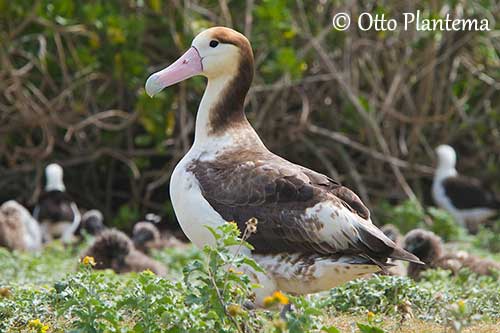
RANGE:
The Short-tailed Albatross is found in North Pacific Ocean and breeds on Torishima Island, off SE Japan, and on two of the Senkaku Islands. It has occasionally bred on Midway Atoll.
This species formerly bred in large numbers in the W North Pacific, on islands south to the main island of Japan.
It forages across the temperate and subarctic North Pacific waters, and may occur in the Gulf of Alaska, along the Aleutian Islands and in the Bering Sea after the breeding season.
HABITAT:
The Short-tailed Albatross nests on volcanic islands with some vegetation including Miscanthus sinensis (family Poaceae) and Chrysanthemum pacificum (family Asteraceae). It also nests on sloping grassy terraces on islands.
Like all albatrosses, it is marine and pelagic.
CALLS AND SONGS:
The Short-tailed Albatross is usually silent at sea, but while competing for food, it produces several sounds such as croaking, shrieking and gargling noises.
During displays, both mates produce throaty cries, grunts and moans. They also perform rapid bill-clattering, resembling a rattling sound, used in courtship but also in threat displays against intruders.
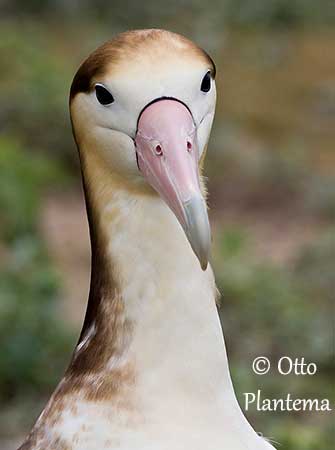
BEHAVIOUR IN THE WILD:
The Short-tailed Albatross feeds on aquatic prey such as squid, fish and shrimps, caught with the bill from the water surface. It also takes refuse and offal from boats.
While competing for food, it is usually dominant among other seabirds such as Norther Fulmar, Black-footed Albatross and other species around the fishing vessels.
The Short-tailed Albatross starts to breed at about 5-6 years old. It is monogamous and usually pairs for life. The usual displays include a variety of stereotyped postures, repeated again and again. They include bill-circling, sky-pointing, flank-touching with the bill and full spreading of wings. These displays are accompanied by various calls.
The yet paired birds do not require such elaborate displays, and their meeting point is usually at the nest-site, reused in several following years.
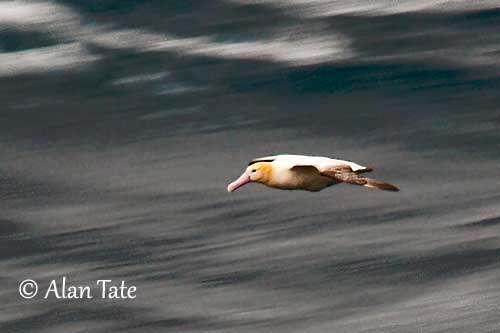
The Short-tailed Albatross moves to rich feeding areas in the North Pacific after the breeding season. It reaches the Gulf of Alaska and the W coast of North America.
The females remain more time off Japan and Russia, whereas males and juveniles move further N and E to Aleutian Islands, Bering Sea and off W North America. The juveniles tend to remain mostly over the continental shelf.
The Short-tailed Albatross is a heavy bird, and its long, narrow wings do not allow powered flight. The bird needs to run over the water surface before to become airborne. The landing is not easy, especially on the breeding islands where it needs a long, narrow stretch of ground free of nests, rocks or trees. Once in the air, it soars easily, often low aver water. It may glide for hours.
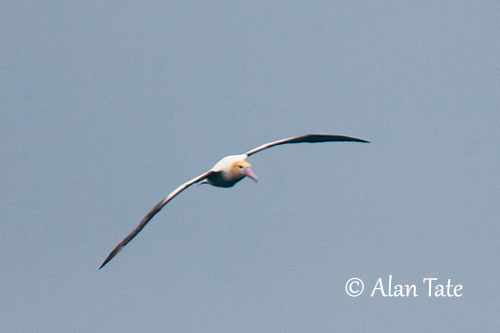
REPRODUCTION OF THIS SPECIES:
The breeding season starts in October, with the egg-laying in late October/early November, and hatching of chicks in late December/early January.
The Short-tailed Albatross is a colonial nester. The nest is made with earth and pieces of vegetation, and the cup is lined with grass. It is placed on the ground, on grassy slopes.
The female lays a single, large egg each year or every other year. Both adults incubate during 65 days, with variable stints, usually sorter for the female. At hatching, the chick has blackish-grey down and dark bill. It is fed by both parents. It remains flightless and depends on adults for about 5 months. It may return to the colony at 4 years of age, with the first breeding between 5 and 8-9 years old.
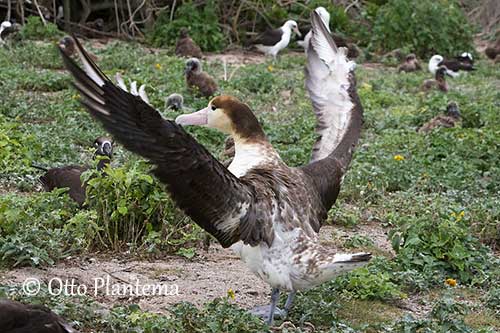
PROTECTION / THREATS / STATUS:
The Short-tailed Albatross was nearly extinct at the beginning of the 20th century, following heavy hunting at breeding colonies in Japan. They were killed primarily for their feathers.
The species was thought to be extinct until 1949. However, in the early 1950s, a few pairs began to breed on Torishima.
The Short-tailed Albatross is still threatened by volcanic eruptions and storms, involving the loss of the breeding habitats. Mortality is also caused by fisheries and introduced predators at colonies. Hooking and drowning on commercial longline gear, plastic debris ingested or given to the chicks, oil spills are the usual current threats.
The population is estimated to number 2,200/2,500 individuals, equating to 1,500/1,700 mature individuals. It is increasing thanks to conservation efforts.
The Short-tailed Albatross is currently listed as Vulnerable.
